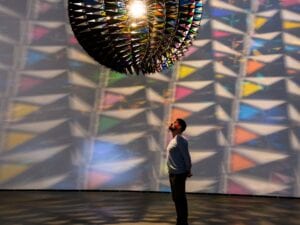A: How did you achieve a cohesive result while exhibiting this varied selection of work?
TW: This exhibition is about great friendships and exchanging ideas. The cohesion in the exhibition comes from from looking at three great artists, at the most significant and prolific part of their lives, when they were friends and exchanged ideas. We looked at the matrix of concerns explored by these masters and we considered the inner relations between works. Their friendship, their approaches, their influence on each other’s provided the background for this exhibition and consequently, the curation came out naturally. This exhibition is the first presentation by Pace London of these artists. It also marks Noland’s first exhibition in the UK since the artist’s death in 2010. It follows the recent announcement of Pace’s representation of the estate of John Hoyland too.
A: Does the exhibition follow a chronological or thematic framework in highlighting the artists’ relationships with one another?
TW: The exhibition covers the period of 1958 to 1977 for Kenneth Noland, 1967 to 1977 for Caro and 1962 to 1975 for John Hoyland. It is obvious that we are exploring a time when they were on each other’s minds. Hoyland, Caro, Noland doesn’t follow a chronological framework and rather focuses on the relationship between these important figures. It also centres on Abstraction. Hoyland, Caro and Noland all emerged in the wake of the first generation of the New York School and sought to continue this legacy. Both Hoyland and Noland shared an interest in the possibilities offered by the new medium of acrylic paint, while Caro continued his exploration of metal, solid abstract shapes and abandoned the malleable clay of his past.
A: Is there a notable evolution in the painting of Hoyland and Noland after encountering Caro’s sculpture, and vice versa?
TW: Tony Caro and Ken Noland were great friends in England and America in the late 1950s. John Hoyland became involved with both of them around 1964. Having encountered Clement Greenberg in London in 1959, Tony Caro first met Ken Noland later that year on a trip to New York. A lifelong friendship and exchange of ideas began, and it was Noland who persuaded Tony Caro to move to Bennington, Vermont, in 1963 with his wife Sheila and two sons, where they remained until 1965. Ken Noland came to London in 1964, where, through Caro, he met John Hoyland as well as the exciting young sculptors David Annesley, Michael Bolus, Phillip King, Tim Scott, William Tucker and Isaac Witkin. On that same trip, Noland met the young dealer Leslie Waddington, a great friend of Greenberg, and Bryan Robertson, who presented solo exhibitions at the Whitechapel Gallery by Caro in 1963 and Hoyland in 1967. When Hoyland joined Emmerich, the gallery also represented Helen Frankenthaler, Adolph Gottlieb, Hans Hofmann, Morris Louis, Barnett Newman, David Smith and a Canadian named Jack Bush.
Already well established as an important colour-field painter and figure in the Washington Colour School, Noland left an indelible impression on Caro with his commitment to the exploration of colour’s effects through serialised forms, including horizontal bands for example. The encounter had its influence on Caro’s practice too, turning him away from the figurative style that had characterised his work at that time and progressing toward the geometric forms he had seen in Noland’s work. It’s important to note that in the exhibition, Caro’s sculptures come from the Noland Estate.
A: Do you feel that the transatlantic exchange of ideas between the artists resulted in a unique form of abstraction?
TW: It was important to Noland to come to England and Caro and Hoyland to go to America. What was going on in NY at the time was very exciting. From the mid-1960s onwards, the three artists continued to exchange and have an awareness of each other’s work. They maintained their friendship, meeting on both sides of the Atlantic and discussed themes of abstraction, structure, materiality and possibilities offered by colour.
Caro returned to the United States in 1964 to teach at Bennington College, where he became closer to Noland, who was living nearby. Caro’s friendship with Hoyland was further strengthened by their trip to Brazil in 1969 when they represented Great Britain together at the São Paulo Bienal. They travelled together, worked together on the display and lived in each other’s pockets the whole time. This friendship lasted thereafter until John’s death in 2011. Greenberg was like a guru to them, but they all spoke out, and Caro and Hoyland were totally accepted into these sessions, which were also generally attended by the likes of Barnett Newman and Morris Louis. All of these artists visited each other’s studios regularly.
Hoyland, Caro, Noland, until 16 January, Pace Gallery, 6 Burlington Gardens, London W1S 3ET.
Learn more at www.pacegallery.com.
Follow us on Twitter @AestheticaMag for the latest news in contemporary art and culture.
Credits
1. Hoyland, Caro, Noland installation view, 2015. Courtesy of Pace Gallery.





